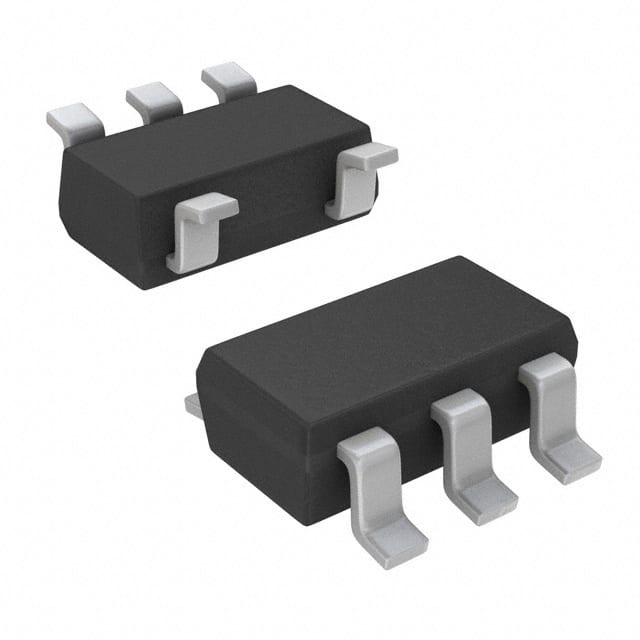Viz Specifikace pro podrobnosti o produktu.

Encyclopedia Entry: 74LVC1G126DCKRG4
Product Overview
Category
The 74LVC1G126DCKRG4 belongs to the category of integrated circuits (ICs) and specifically falls under the family of logic gates.
Use
This product is commonly used in digital electronics for signal switching and amplification purposes. It acts as a buffer or driver, enabling the control of signals between different components within a circuit.
Characteristics
- Low-voltage CMOS technology
- Single gate functionality
- High-speed operation
- Wide operating voltage range
- Low power consumption
- Schmitt-trigger input for noise immunity
Package
The 74LVC1G126DCKRG4 is available in a small SOT-353 package, which is compact and suitable for space-constrained applications.
Essence
The essence of this product lies in its ability to provide reliable signal buffering and driving capabilities while operating at low voltages and consuming minimal power.
Packaging/Quantity
Typically, the 74LVC1G126DCKRG4 is supplied in reels or tubes, with each reel containing a specific quantity of ICs. The exact packaging and quantity may vary depending on the manufacturer's specifications.
Specifications
- Supply Voltage Range: 1.65V to 5.5V
- Input Voltage Range: 0V to VCC
- Output Voltage Range: 0V to VCC
- Maximum Operating Frequency: 500 MHz
- Maximum Propagation Delay: 3.8 ns
- Maximum Quiescent Current: 10 μA
- Operating Temperature Range: -40°C to +125°C
Detailed Pin Configuration
The 74LVC1G126DCKRG4 features a total of five pins:
- GND (Ground): Connected to the ground reference potential.
- VCC (Supply Voltage): Connected to the positive supply voltage.
- A (Input): Input pin for the signal to be buffered or driven.
- Y (Output): Output pin for the buffered or driven signal.
- OE (Output Enable): Control pin to enable or disable the output.
Functional Features
- Buffering: The 74LVC1G126DCKRG4 can buffer weak input signals, ensuring their integrity and preventing degradation during transmission.
- Driving: It can drive signals with sufficient strength to overcome capacitive loads and maintain signal quality.
- Schmitt-trigger Input: The Schmitt-trigger input allows for noise immunity, ensuring reliable operation even in noisy environments.
- Low Power Consumption: This IC is designed to minimize power consumption, making it suitable for battery-powered applications.
- Wide Operating Voltage Range: The device can operate within a wide range of supply voltages, providing flexibility in various circuit designs.
Advantages and Disadvantages
Advantages
- Compact size enables usage in space-constrained applications.
- High-speed operation allows for efficient signal processing.
- Low power consumption prolongs battery life in portable devices.
- Wide operating voltage range provides versatility in different voltage domains.
- Schmitt-trigger input enhances noise immunity, ensuring reliable signal processing.
Disadvantages
- Limited functionality as a single gate, may require additional components for complex logic operations.
- Propagation delay may impact real-time applications requiring immediate response.
Working Principles
The 74LVC1G126DCKRG4 operates based on CMOS technology, utilizing MOSFET transistors to control the flow of current through its internal circuitry. When an input signal is applied, the internal transistors switch states, allowing the signal to be buffered or driven to the output pin. The Schmitt-trigger input ensures noise immunity by providing hysteresis, which helps prevent false triggering due to noise.
Detailed Application Field Plans
The 74LVC1G126DCKRG4 finds applications in various fields, including but not limited to:
- Consumer Electronics: Used in smartphones, tablets, and portable media players for signal buffering and driving.
- Automotive: Employed in automotive electronics for signal conditioning and amplification.
- Industrial Automation: Utilized in control systems and PLCs for signal switching and interfacing.
- Internet of Things (IoT): Integrated into IoT devices for sensor data processing and communication.
- Medical Devices: Incorporated in medical equipment for signal conditioning and amplification.
Detailed and Complete Alternative Models
- 74LVC1G125DCKRG4
- SN74LVC1G126DBVR
- MC74LVC1G126DTT1G
- TC7SZ126AFK(TE85L,F)
These alternative models offer similar functionality and can be used as substitutes for the 74LVC1G126DCKRG4, depending on specific requirements and availability.
In conclusion, the 74LVC1G126DCK
Seznam 10 běžných otázek a odpovědí souvisejících s aplikací 74LVC1G126DCKRG4 v technických řešeních
Sure! Here are 10 common questions and answers related to the application of 74LVC1G126DCKRG4 in technical solutions:
Q1: What is the 74LVC1G126DCKRG4? A1: The 74LVC1G126DCKRG4 is a single bus buffer gate with three-state output, designed for low-voltage (1.65V to 5.5V) applications.
Q2: What is the purpose of the 74LVC1G126DCKRG4? A2: The purpose of this IC is to provide buffering and level shifting capabilities for digital signals in various electronic circuits.
Q3: What are the key features of the 74LVC1G126DCKRG4? A3: Some key features include high-speed operation, low power consumption, wide voltage range, and compatibility with both CMOS and TTL logic levels.
Q4: What is the maximum operating frequency of the 74LVC1G126DCKRG4? A4: The maximum operating frequency of this IC is typically around 400 MHz.
Q5: How many input/output pins does the 74LVC1G126DCKRG4 have? A5: It has one input pin and one output pin.
Q6: Can the 74LVC1G126DCKRG4 handle bidirectional signals? A6: No, it is a unidirectional buffer and cannot handle bidirectional signals.
Q7: What is the output drive strength of the 74LVC1G126DCKRG4? A7: The output drive strength is typically 32 mA.
Q8: Is the 74LVC1G126DCKRG4 suitable for battery-powered applications? A8: Yes, it is designed for low-power applications and can be used in battery-powered devices.
Q9: Can the 74LVC1G126DCKRG4 tolerate overvoltage on its inputs? A9: Yes, it has protection diodes that allow it to tolerate voltages higher than its supply voltage.
Q10: What is the package type of the 74LVC1G126DCKRG4? A10: It comes in a small SOT-353 package, which is also known as SC-88A or DCK.

